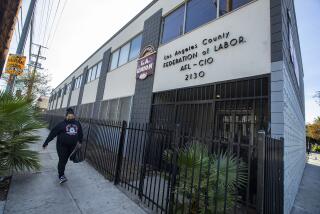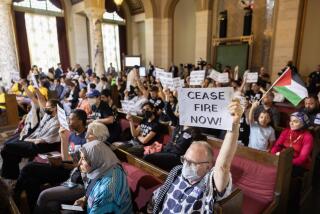Councilman Gunned Down by Rival in N.Y. City Hall
- Share via
NEW YORK — A Brooklyn city councilman was shot dead Wednesday by a political rival who sneaked a handgun past City Hall security with the councilman’s unwitting help, authorities said. Seconds later, the assailant was slain by a police officer firing up into the crowded balcony of the ornate, historic chamber.
Councilman James E. Davis, a former police officer who had become a grass-roots crusader against urban violence, was shot in the chest by Othniel Askew, a frustrated contender for Davis’ council seat. More than 100 people, including Davis and Askew, were jammed into the visitors balcony when the shots rang out, sparking panic throughout the building.
“This is a sad moment for New York,” said a somber Mayor Michael R. Bloomberg, who called the City Hall shootings “as tough a day as I’ve had in 61 years.” But he also voiced concern over the security breach that allowed Askew, 31, to bring a handgun into the building, which has been heavily guarded since the Sept. 11, 2001, terrorist attacks.
“Obviously, there was a breakdown someplace,” Bloomberg said, noting that Davis, 41, had escorted Askew into City Hall minutes before the 2:08 p.m. shooting. The councilman and his guest, availing themselves of a courtesy extended to elected officials, bypassed the metal detection devices that normally screen all traffic into the building, Bloomberg said.
Several hours after the killings, the mayor announced that all people entering City Hall -- including elected officials -- would henceforth have to go through detectors. The heightened security was needed, he said, “even though we don’t want to shut down people’s right to visit City Hall and express themselves.”
Bloomberg said the shooting was not related to terrorism but that the precise motive remained unclear. “It does not appear there is anything else to the story other than a dispute between two men,” the mayor said. Officials said Askew was angry that he had been denied a spot on the upcoming Democratic primary ballot.
Late Wednesday morning, FBI officials notified New York police that a man who identified himself as Askew had called the FBI to complain that Davis had been harassing him over the upcoming council election. The man did not make any specific threats against the councilman, authorities added.
Davis’ and Askew’s bodies were found lying next to each other after an estimated 12 to 14 shots echoed through the council chambers. Politicians and staff members dived under desks and cubicles, and pandemonium broke out among hundreds of people who had been visiting City Hall, which is four blocks from the World Trade Center site.
Police quickly evacuated the building and herded large crowds to a park surrounding the 191-year-old building, while heavily armed SWAT teams searched every room. Officials briefly shut down the Brooklyn and Manhattan bridges; subway cars were diverted from the area, and automobile traffic in and out of the Civic Center was halted for nearly two hours.
Although police initially feared that the gunman had slipped away, officials were quickly able to piece together what had happened:
Askew, a businessman, had wanted to run for Davis’ council seat, which represents mainly the Brooklyn neighborhoods of Fort Greene and Clinton Hill. But he had failed to get enough signatures to qualify for a place on the fall Democratic primary ballot and was frustrated by the city’s often arcane election requirements, officials said. Earlier in the day, he had met in his Fort Greene office with Davis, and the two men agreed to meet later at City Hall.
Davis, a popular politician who took pride in knowing virtually all of the political activists in his district, did not know Askew until a month ago, colleagues said. Before Wednesday, Askew had visited the councilman’s office “a few times” in recent weeks, Davis’ spokeswoman, Amyre Loomis, told Associated Press.
“He was approaching the councilman in a mentor-type role,” Loomis said, but “he always appeared to be a bit on the strange side.”
Shortly before 2 p.m., Police Commissioner Ray Kelly said that City Hall surveillance videotapes caught Davis and Askew entering the building by the western gate. Councilman Charles Barron of Brooklyn, who met Davis and Askew as they entered the City Council chambers, told reporters that Davis introduced him to Askew, saying: “This is the guy who was once against me, but now he’s with me.” Barron recalled shaking hands with Askew and smiling, but getting a very intense stare in return.
“Oh, he’s a military guy,” Barron recalled Davis telling him, as Davis and his guest began heading toward a stairway leading to the balcony. “Don’t worry. He’ll relax.”
Minutes later, Barron and his colleagues looked up in disbelief as Askew pulled out a silver semiautomatic handgun and began firing point blank at Davis. The councilman, who had a license to carry a handgun, did not have time to fire back at his assailant, according to Kelly. Askew continued to shoot at Davis after the councilman fell to the ground until the gunman was slain by Richard Burt, a 34-year-old plainclothes policeman who was guarding the second-floor chambers. Burt fired six to seven shots up into the third-floor balcony, Kelly said.
Council members who witnessed the shootings voiced grief over Davis’ killing and anger over the lax City Hall security system that had led to his death.
“How the hell could this have happened?” a visibly shaken Councilman Michael Nelson said to reporters after police evacuated the building. “How could shots go off and I’m on the floor?”
“It was surreal; we felt it was a joke, maybe somebody playing with firecrackers, when the shots began going off,” Councilman Leroy Comrie said outside City Hall. “Then we looked up and saw something terrible happening.”
Councilman Miguel Martinez of Washington Heights said Speaker Gifford Miller began shouting, “Get down!” when the firing started, and Martinez said he was immediately fearful for Davis, whom he had spotted moments before in the balcony “talking to some folks.”
Visitors to City Hall were equally shaken. Debbie Almontasser and other members of Women in Islam had just received a City Council proclamation and were being photographed outside the chamber when they heard the shots. They were shoved into a nearby ladies’ room, where Almontasser dialed 911 on a cellphone.
She told the operator that there had been a shooting at City Hall, and when the operator asked, “Which City Hall?” Almontasser said she answered: “New York City Hall!” She and her colleagues said they found it strange that a gunman could have entered the building at a time when they, as garbed Muslim women, are constantly being checked by security.
“Given the climate we’re in, I was wondering: How could this happen?” she said.
Davis, who formed a grass-roots group called “Love Yourself” Stop the Violence, had crusaded against gang killings and other gun-related crimes. A political maverick, he had bucked the Democratic political machine in Brooklyn and was elected in 2001.
He first came to New Yorkers’ attention in 1983, when he was allegedly beaten by two white police officers while driving his mother’s automobile. The case was covered by the news media, and Davis later joined the Police Department, vowing to curb violence against minorities. He formed the nonprofit advocacy group in 1990, and was working on a graduate degree in sociology at the time of his death.
Davis’ family members raced to New York University’s Downtown Medical Center, where doctors failed to revive the councilman. In an emotional statement to reporters, his brother Geoffrey said, “The system did this” and blamed “white racists” and “black racists” for the scourge of violence in American society.
Although the shootings shocked New Yorkers, it was not the first time that an American city hall had been plagued by violence. In 1978, San Francisco Mayor George R. Moscone and Supervisor Harvey Milk, the nation’s first openly gay elected official, were slain by a former supervisor, Dan White.
White, a former police officer, slipped into City Hall by a basement window, avoiding metal detectors, and then entered the mayor’s office by a little-used hallway door, escaping detection by the mayor’s bodyguards.
In a controversial trial, White was convicted of second-degree manslaughter after pleading diminished capacity and served five years in prison. He committed suicide a year after his release.
The San Francisco City Hall shootings prompted tougher security measures in public buildings all over America. But those standards were eventually relaxed, just as they were stiffened but gradually loosened after the Sept. 11 terrorist attacks.
Los Angeles City Hall has similar security measures as in New York. Security guards have always monitored the entrances to City Hall, but after the terrorism attacks, the public was limited to one entrance and metal detectors were installed.
About eight months ago, however, the city began allowing elected officials and city employees with valid city identification cards to go around the metal detectors after staff members complained that the screening process was too cumbersome. In addition, officials can bring guests in the building who are allowed to bypass security.
“Could this happen here? Yes,” said Jon Mukri, the general manager of Los Angeles’ General Services Department, which is in charge of security in city buildings.
Additional security officers were immediately sent to the council chamber Wednesday morning after the shooting in New York, Mukri said.
Los Angeles officials will revisit the overall security measures at City Hall, he added. Mukri said he has already fielded phone calls from some council members about the incident, and he added that city police officials are consulting with the New York Police Department.
“There’s always that debate,” Mukri said. “This is a city facility and it was built to have open and unhampered access.... But unless you have everyone go through the metal detectors, you really don’t have 100% positive control.”
*
Times staff writer Matea Gold in Los Angeles contributed to this report.
More to Read
Sign up for Essential California
The most important California stories and recommendations in your inbox every morning.
You may occasionally receive promotional content from the Los Angeles Times.










